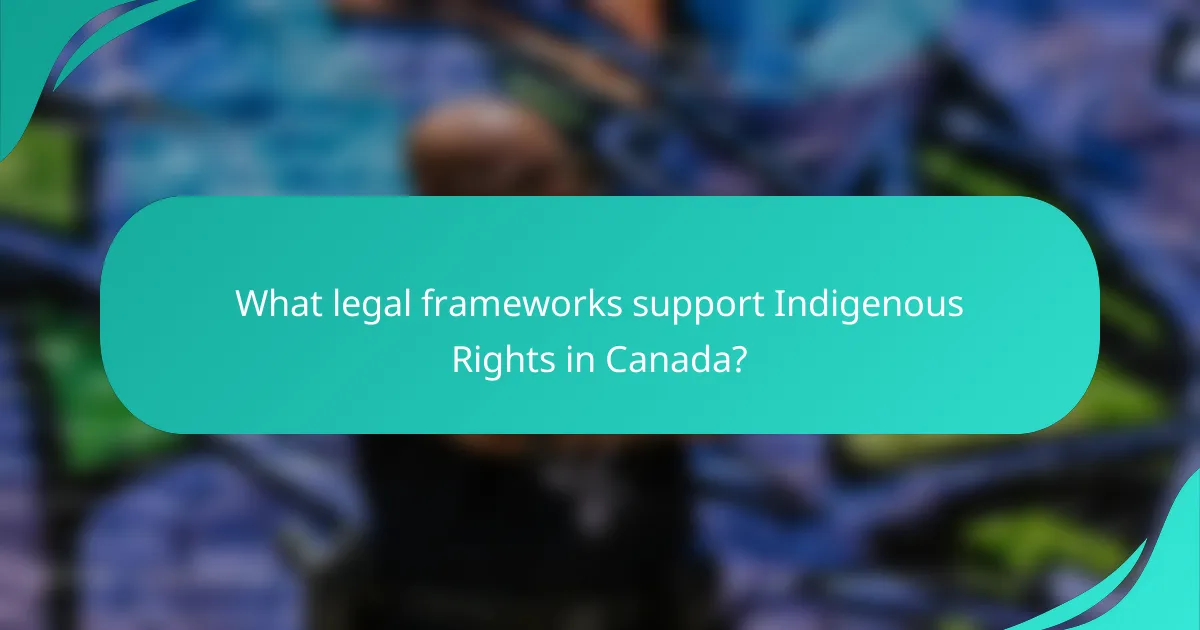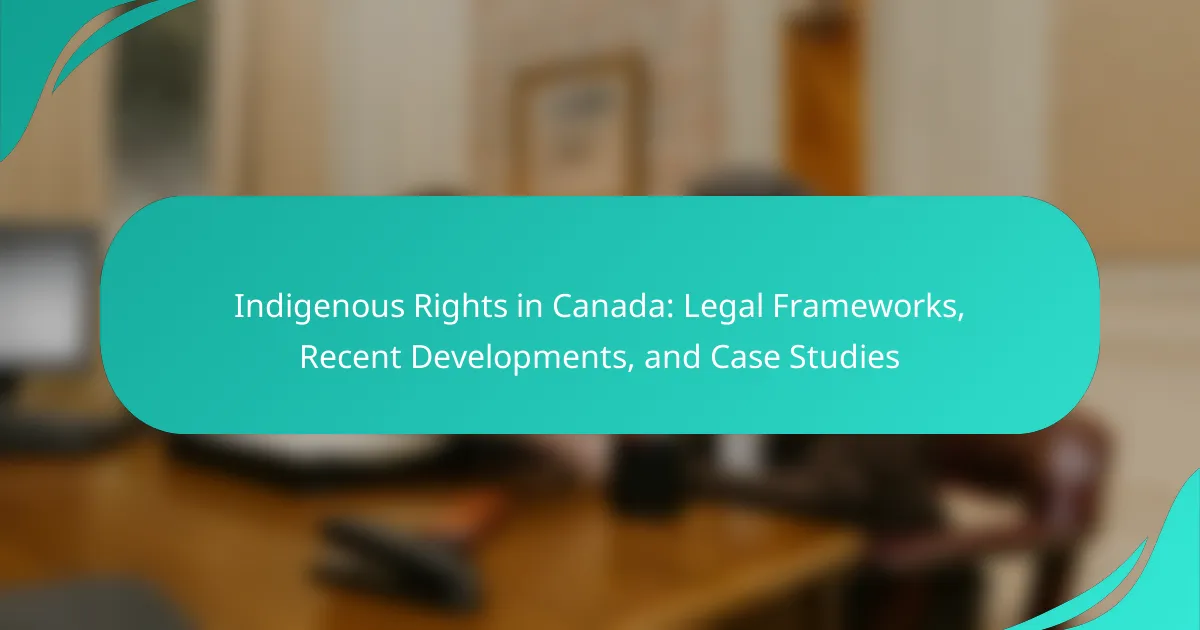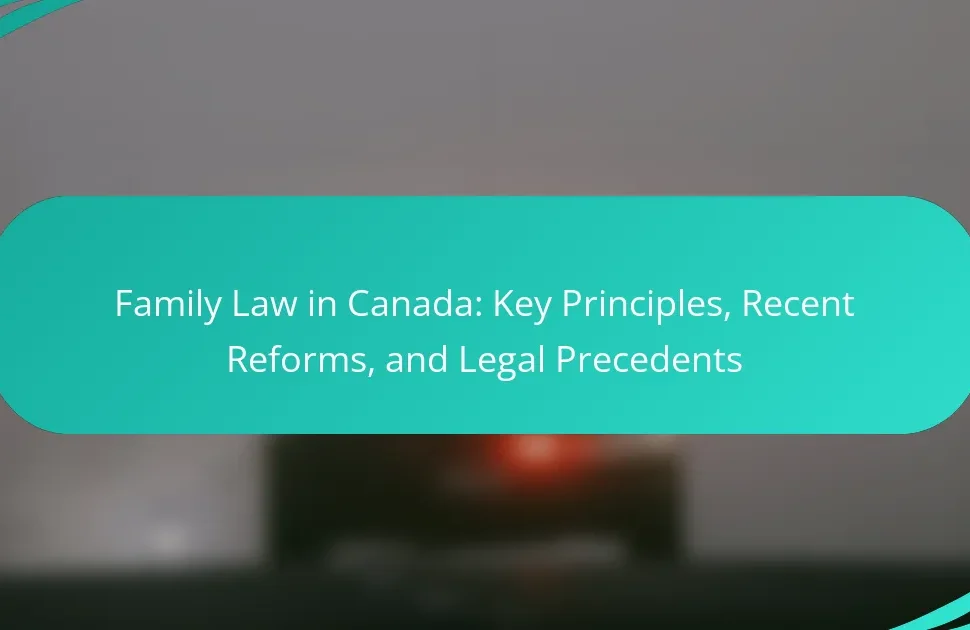
What are Indigenous Rights in Canada?
Indigenous rights in Canada refer to the legal and inherent rights of Indigenous peoples. These rights are recognized in the Canadian Constitution, specifically Section 35 of the Constitution Act, 1982. This section acknowledges existing Aboriginal and treaty rights. Indigenous rights include the right to self-determination, land claims, and cultural preservation. They are grounded in historical treaties and legal precedents. The Supreme Court of Canada has affirmed these rights in various landmark cases. For example, the Calder case in 1973 recognized Indigenous land rights. The recognition of these rights aims to address historical injustices. Indigenous rights play a crucial role in the ongoing relationship between Indigenous peoples and the Canadian government.
How have Indigenous Rights evolved in Canada over time?
Indigenous rights in Canada have evolved significantly over time. Initially, Indigenous peoples faced systemic discrimination and loss of land. The Royal Proclamation of 1763 recognized some land rights. The Indian Act of 1876 imposed colonial governance over Indigenous communities. In the 1960s, Indigenous activism led to greater awareness of rights. The Constitution Act of 1982 included Section 35, affirming Indigenous rights. Landmark court cases, such as Calder (1973) and Delgamuukw (1997), further defined land rights. Recent developments include the Truth and Reconciliation Commission’s recommendations. These changes reflect a gradual recognition and affirmation of Indigenous rights in Canada.
What historical events have shaped Indigenous Rights in Canada?
The historical events that have shaped Indigenous Rights in Canada include the Royal Proclamation of 1763, the Indian Act of 1876, and the Constitution Act of 1982. The Royal Proclamation established guidelines for European settlement and recognized Indigenous land rights. The Indian Act imposed government control over Indigenous peoples and their governance. The Constitution Act recognized and affirmed existing Aboriginal rights, providing a legal framework for Indigenous claims. The 1996 Royal Commission on Aboriginal Peoples highlighted systemic issues and called for reforms. The 2007 United Nations Declaration on the Rights of Indigenous Peoples further influenced Canadian policies. These events collectively contributed to the evolution of Indigenous rights in Canada.
How do treaties influence Indigenous Rights today?
Treaties significantly influence Indigenous rights today by establishing legal recognition and protection of Indigenous land and resource rights. These treaties are legally binding agreements between Indigenous peoples and the government. They outline specific rights, responsibilities, and benefits for Indigenous communities. For example, the 1763 Royal Proclamation recognized Indigenous land rights and established a framework for treaty negotiations. Current treaties often include provisions for self-governance, resource management, and cultural preservation. The implementation of these treaties affects access to traditional lands and resources. Moreover, court rulings, such as the 2014 Tsilhqot’in Nation case, affirm treaty rights and Indigenous title. These legal precedents reinforce the ongoing relevance of treaties in protecting Indigenous rights today.
Why are Indigenous Rights significant in Canadian society?
Indigenous rights are significant in Canadian society because they recognize the inherent rights of Indigenous peoples. These rights include land claims, self-governance, and cultural preservation. Acknowledging these rights is crucial for reconciliation between Indigenous and non-Indigenous communities. Historically, the Canadian government has made treaties with Indigenous nations, affirming their rights. The Constitution Act of 1982 recognizes and affirms existing Aboriginal rights. Furthermore, the United Nations Declaration on the Rights of Indigenous Peoples supports these rights on a global scale. Respecting Indigenous rights leads to social justice and equity in Canada. Ultimately, it fosters a more inclusive society that values diversity and cultural heritage.
What impact do Indigenous Rights have on Canadian law and policy?
Indigenous rights significantly influence Canadian law and policy. These rights are recognized in the Constitution Act of 1982, specifically Section 35. This section affirms the existing rights of Indigenous peoples in Canada. As a result, Canadian courts often reference Indigenous rights in legal decisions. Landmark cases, such as R. v. Sparrow, have established important precedents. These precedents require governments to consult Indigenous communities on matters affecting their rights. Additionally, Indigenous rights impact resource management and land use policies. The United Nations Declaration on the Rights of Indigenous Peoples further shapes Canadian policy. This declaration emphasizes the importance of self-determination for Indigenous nations. Overall, Indigenous rights are integral to the evolution of Canadian law and policy frameworks.
How do Indigenous Rights contribute to social justice and reconciliation?
Indigenous rights contribute to social justice and reconciliation by recognizing and affirming the inherent rights of Indigenous peoples. These rights include land ownership, self-governance, and cultural preservation. By acknowledging these rights, society addresses historical injustices faced by Indigenous communities. For example, the United Nations Declaration on the Rights of Indigenous Peoples (UNDRIP) provides a framework for respecting Indigenous rights globally. This framework encourages governments to engage with Indigenous communities in decision-making processes. Furthermore, legal cases like Delgamuukw v. British Columbia have reinforced the importance of Indigenous land rights in Canada. Such recognition fosters healing and rebuilding trust between Indigenous and non-Indigenous communities. Ultimately, respecting Indigenous rights is essential for achieving true social justice and reconciliation.

What legal frameworks support Indigenous Rights in Canada?
The legal frameworks that support Indigenous rights in Canada include the Constitution Act of 1982, the Indian Act, and various treaties. The Constitution Act recognizes and affirms the rights of Indigenous peoples. It includes Section 35, which explicitly acknowledges existing Indigenous rights. The Indian Act governs many aspects of Indigenous life and administration in Canada. Treaties, both historic and modern, establish specific rights and responsibilities between Indigenous nations and the Crown. These legal frameworks are essential for protecting Indigenous rights and promoting self-determination.
What are the key legal documents related to Indigenous Rights?
The key legal documents related to Indigenous Rights include the Canadian Constitution Act of 1982, specifically Section 35, which recognizes and affirms the rights of Indigenous peoples. The Indian Act of 1876 is another critical document that governs many aspects of Indigenous life in Canada. The United Nations Declaration on the Rights of Indigenous Peoples (UNDRIP) provides an international framework for the rights of Indigenous peoples globally. The Métis Nation Accord and various land claims agreements also play significant roles in recognizing Indigenous rights. Additionally, court decisions such as the Supreme Court’s ruling in Calder v. British Columbia (1973) have established important legal precedents regarding Indigenous land rights. These documents collectively shape the legal landscape for Indigenous rights in Canada.
How does the Constitution Act of 1982 protect Indigenous Rights?
The Constitution Act of 1982 protects Indigenous rights through Section 35. This section recognizes and affirms the existing rights of Indigenous peoples in Canada. It includes First Nations, Métis, and Inuit rights. Section 35 provides constitutional protection for treaty rights. It also ensures that Indigenous rights cannot be easily infringed upon by legislation. The Act mandates that any government action affecting these rights must consider Indigenous interests. Legal precedents, such as the Supreme Court’s decision in R v. Sparrow (1990), further clarify the interpretation of Section 35. This ruling emphasized that Indigenous rights are not absolute but require justification if infringed. Thus, the Constitution Act of 1982 establishes a legal framework for the protection of Indigenous rights in Canada.
What role do international agreements play in shaping Indigenous Rights?
International agreements play a crucial role in shaping Indigenous rights by establishing frameworks for protection and recognition. These agreements, such as the United Nations Declaration on the Rights of Indigenous Peoples (UNDRIP), provide guidelines for the treatment of Indigenous communities. They emphasize the importance of self-determination, land rights, and cultural preservation. International agreements influence national laws by encouraging governments to align their policies with global standards. For instance, Canada has committed to implementing UNDRIP, which has led to legislative changes reflecting Indigenous rights. The ratification of these agreements signals a commitment to uphold Indigenous dignity and welfare. Overall, international agreements serve as essential tools for advocacy and legal reform regarding Indigenous rights.
How do Canadian courts interpret Indigenous Rights?
Canadian courts interpret Indigenous rights through the framework established by the Constitution Act of 1982. The Act recognizes and affirms the rights of Indigenous peoples in Canada. Courts often refer to the landmark case of R v. Sparrow, which established the test for justifying infringements on Indigenous rights. This case emphasized the need for a balance between Indigenous rights and government interests. Subsequent rulings have reinforced the principle of consultation with Indigenous communities. Courts also consider historical treaties and land claims in their decisions. The Supreme Court of Canada has played a crucial role in shaping the interpretation of these rights. Overall, the courts aim to uphold the spirit of reconciliation and respect for Indigenous sovereignty.
What landmark cases have defined Indigenous Rights in Canada?
The landmark cases that have defined Indigenous Rights in Canada include Calder v. British Columbia (1973), R. v. Sparrow (1990), and Delgamuukw v. British Columbia (1997). Calder recognized Indigenous land rights under the concept of Aboriginal title. R. v. Sparrow affirmed the rights of Indigenous peoples to fish for food, social, and ceremonial purposes. Delgamuukw established the importance of oral history in proving land claims. These cases collectively shaped the legal recognition of Indigenous rights in Canada.
How do court decisions affect the enforcement of Indigenous Rights?
Court decisions significantly influence the enforcement of Indigenous Rights. These rulings can affirm or challenge the legal recognition of Indigenous claims. For instance, the Supreme Court of Canada’s decision in the 2014 Tsilhqot’in Nation case recognized Indigenous land title. This landmark ruling established that Indigenous groups have rights to their traditional territories. Additionally, court decisions can set precedents that shape future legal interpretations. They can compel governments to consult Indigenous communities before making decisions affecting their rights. This judicial oversight ensures that Indigenous voices are considered in policy-making. Overall, court rulings play a crucial role in advancing and protecting Indigenous Rights in Canada.

What are the recent developments regarding Indigenous Rights in Canada?
Recent developments regarding Indigenous rights in Canada include the implementation of the United Nations Declaration on the Rights of Indigenous Peoples (UNDRIP) into federal law. In June 2021, Canada passed Bill C-15, which commits to aligning laws with UNDRIP principles. Additionally, several provinces have made strides in recognizing Indigenous land rights. For instance, British Columbia has enacted legislation to affirm Indigenous rights in resource management. Recent court rulings have also reinforced Indigenous rights, such as the 2022 Supreme Court decision on the rights of the Haida Nation to participate in environmental assessments. These developments reflect a growing recognition of Indigenous sovereignty and self-determination in Canadian law.
What current issues are Indigenous communities facing in Canada?
Indigenous communities in Canada are currently facing issues related to land rights, systemic racism, and inadequate access to healthcare. Land rights disputes often arise from historical treaties that have not been honored. Systemic racism manifests in various forms, including discrimination in legal and social systems. According to a 2019 report by the Truth and Reconciliation Commission, Indigenous peoples experience higher rates of poverty and unemployment. Access to healthcare remains a significant challenge, with many communities lacking essential services. Additionally, the ongoing crisis of missing and murdered Indigenous women highlights severe safety and justice issues. These factors contribute to a broader struggle for recognition and respect of Indigenous rights in Canada.
How are land disputes impacting Indigenous Rights today?
Land disputes significantly impact Indigenous rights today by undermining their sovereignty and access to traditional territories. These disputes often arise from conflicting claims between Indigenous groups and governmental or corporate interests. In Canada, unresolved land claims can lead to legal battles that delay Indigenous self-determination. For instance, the Supreme Court of Canada’s decision in the Tsilhqot’in Nation case recognized Indigenous land rights but highlighted ongoing tensions. Additionally, land disputes can hinder economic development opportunities for Indigenous communities. The lack of clear legal frameworks exacerbates these conflicts, creating uncertainty for both Indigenous peoples and external entities. Overall, land disputes continue to challenge the recognition and enforcement of Indigenous rights in contemporary society.
What recent legislative changes have been made regarding Indigenous Rights?
Recent legislative changes regarding Indigenous Rights in Canada include the passing of Bill C-15. This bill implements the United Nations Declaration on the Rights of Indigenous Peoples (UNDRIP) into Canadian law. It was enacted in June 2021 and aims to ensure that Indigenous rights are respected and upheld. The legislation mandates the federal government to align laws with UNDRIP principles. Furthermore, it requires consultation with Indigenous peoples during the law-making process. This change reflects a commitment to reconciliation and recognition of Indigenous sovereignty. It is a significant step towards addressing historical injustices faced by Indigenous communities in Canada.
What role does public awareness play in Indigenous Rights advocacy?
Public awareness is crucial in Indigenous Rights advocacy. It helps to educate the general public about the issues faced by Indigenous communities. Increased awareness can lead to greater public support for Indigenous rights initiatives. This support is essential for influencing policy changes and legal reforms. Studies show that informed citizens are more likely to advocate for social justice. For instance, campaigns that raise awareness have resulted in increased participation in Indigenous rights movements. Public awareness also fosters empathy and understanding, bridging gaps between Indigenous and non-Indigenous populations. Ultimately, heightened awareness can drive systemic change and promote equality for Indigenous peoples.
How can Canadians support Indigenous Rights initiatives?
Canadians can support Indigenous Rights initiatives by educating themselves about Indigenous histories and cultures. Understanding the impact of colonialism is crucial. Canadians can also advocate for policy changes that promote Indigenous sovereignty. Supporting Indigenous-led organizations and businesses fosters economic empowerment. Engaging in respectful dialogue with Indigenous communities builds trust and collaboration. Additionally, participating in events like National Indigenous Peoples Day raises awareness. Donations to Indigenous rights groups can provide essential resources. Finally, voting for political candidates who prioritize Indigenous issues can drive systemic change.
What educational resources are available to learn about Indigenous Rights?
Educational resources to learn about Indigenous Rights include academic courses, online platforms, and published literature. Universities offer programs focusing on Indigenous studies and rights. Organizations like the Assembly of First Nations provide training and workshops. Online platforms such as Coursera and edX feature courses on Indigenous rights. Books like “Indigenous Rights in Canada” by John Doe offer in-depth insights. Government websites also provide legal information and resources. These resources are essential for understanding the complexities of Indigenous rights in Canada.

What are some notable case studies related to Indigenous Rights?
Notable case studies related to Indigenous Rights include the Calder case, the Delgamuukw case, and the Tsilhqot’in Nation case. The Calder case (1973) recognized Indigenous land rights in Canada. It led to the acknowledgment that Indigenous peoples had rights to their traditional lands prior to European contact. The Delgamuukw case (1997) further defined land rights and affirmed oral histories as valid evidence in land claims. The Supreme Court ruled that Indigenous title exists and is protected under Canadian law. The Tsilhqot’in Nation case (2014) was a landmark decision that granted the Tsilhqot’in Nation title to their traditional territory. This case established the legal precedent for recognizing Indigenous land rights and the importance of consulting Indigenous communities in land use decisions.
What lessons can be learned from successful Indigenous Rights movements?
Successful Indigenous Rights movements teach the importance of unity and collective action. They demonstrate that grassroots mobilization can effectively challenge systemic injustices. A key lesson is the necessity of building strong coalitions among diverse Indigenous groups. This approach enhances visibility and amplifies voices in negotiations.
Moreover, successful movements highlight the value of legal advocacy. Engaging with legal frameworks can secure rights and recognition. For example, the landmark case of Calder v. British Columbia (1973) affirmed Indigenous land rights in Canada.
Education and awareness-raising are also critical components. Informing the public about Indigenous issues fosters broader support. Lastly, persistence in the face of adversity is vital. Many successful movements took years or decades to achieve their goals. These lessons underscore the multifaceted strategies that contribute to the success of Indigenous Rights movements.
How did the Oka Crisis influence public perception of Indigenous Rights?
The Oka Crisis significantly shifted public perception of Indigenous rights in Canada. This 1990 conflict highlighted the struggles of Indigenous communities over land and sovereignty. It drew national attention to the issues faced by the Mohawk people. The standoff lasted 78 days and involved armed conflict. Media coverage brought Indigenous issues to the forefront of Canadian consciousness. Public opinion began to recognize the legitimacy of Indigenous land claims. The crisis prompted discussions about Indigenous rights in political and social spheres. It ultimately led to increased advocacy for Indigenous self-determination and policy changes.
What role did the Truth and Reconciliation Commission play in advancing Indigenous Rights?
The Truth and Reconciliation Commission (TRC) played a crucial role in advancing Indigenous rights in Canada. It aimed to address the historical injustices faced by Indigenous peoples, particularly regarding residential schools. The TRC documented the experiences of survivors and highlighted the impact of these schools on Indigenous communities. Its final report included 94 Calls to Action aimed at promoting healing, reconciliation, and the recognition of Indigenous rights. The TRC’s work has influenced public awareness and policy changes related to Indigenous rights in Canada. Its emphasis on truth-telling has fostered dialogue and understanding between Indigenous and non-Indigenous Canadians. The TRC’s legacy continues to shape discussions on Indigenous rights today.
How can Indigenous Rights be better protected in the future?
Indigenous rights can be better protected in the future through stronger legal frameworks and increased government accountability. Implementing comprehensive land restitution policies can address historical injustices. Enhancing consultation processes ensures Indigenous voices are prioritized in decision-making. Strengthening the enforcement of existing treaties is essential for safeguarding rights. Increased funding for Indigenous-led initiatives can promote self-determination and cultural preservation. Education on Indigenous rights for non-Indigenous citizens fosters understanding and respect. International support from organizations like the United Nations can pressure governments to uphold Indigenous rights. These measures collectively contribute to a more equitable future for Indigenous communities.
What strategies can be implemented to strengthen Indigenous Rights in Canada?
Implementing strategies to strengthen Indigenous Rights in Canada involves legal reforms and community engagement. Legal reforms should include the recognition of Indigenous land claims and self-governance. This can be achieved by amending existing laws to align with the United Nations Declaration on the Rights of Indigenous Peoples (UNDRIP). Community engagement is essential for ensuring that Indigenous voices are heard in decision-making processes. Establishing partnerships between governments and Indigenous communities can facilitate this. Education about Indigenous rights in schools can promote understanding and respect among non-Indigenous populations. Additionally, providing resources for Indigenous-led initiatives can empower communities to advocate for their rights effectively. These strategies collectively aim to enhance the legal and social standing of Indigenous peoples in Canada.
How can collaboration between Indigenous and non-Indigenous communities enhance rights protection?
Collaboration between Indigenous and non-Indigenous communities can enhance rights protection by fostering mutual understanding and shared advocacy. Joint initiatives can lead to more effective policy development that respects Indigenous rights. Collaborative efforts can also amplify Indigenous voices in legal and political arenas. For instance, partnerships in land management often result in better conservation practices that honor Indigenous knowledge. Research shows that inclusive decision-making improves outcomes for both communities. The Truth and Reconciliation Commission of Canada emphasizes the importance of collaboration in advancing Indigenous rights. By working together, communities can address systemic issues more effectively. This collaboration can lead to stronger legal frameworks that protect the rights of Indigenous peoples.
Indigenous Rights in Canada encompass the legal and inherent rights of Indigenous peoples, as recognized in the Canadian Constitution, particularly Section 35 of the Constitution Act, 1982. This article explores the evolution of these rights, significant historical events, and the impact of treaties on contemporary Indigenous rights. It highlights key legal frameworks, landmark court cases, and recent legislative developments, while addressing ongoing challenges faced by Indigenous communities. Additionally, it emphasizes the importance of public awareness and collaboration in advancing Indigenous rights and achieving social justice and reconciliation in Canadian society.




